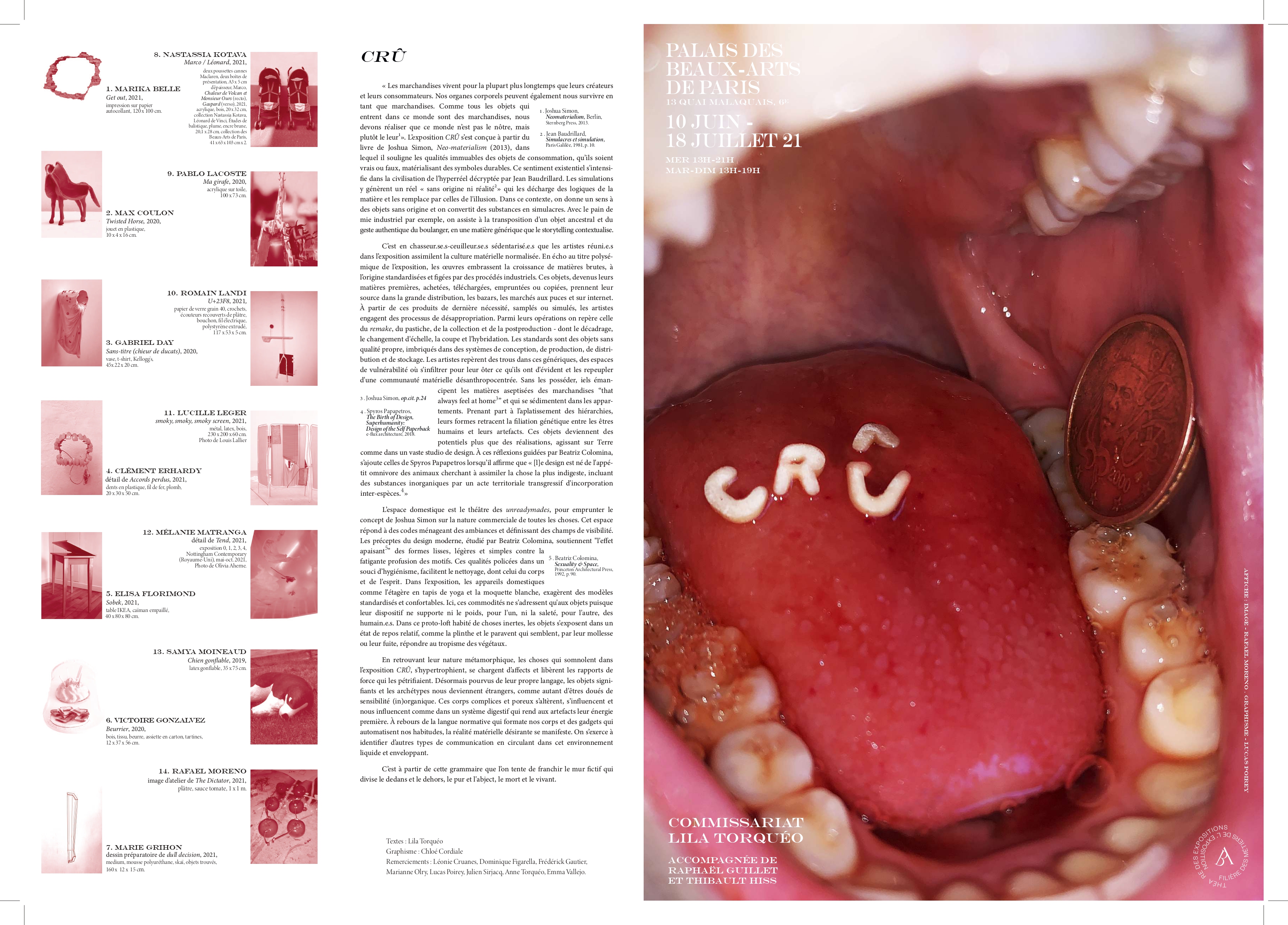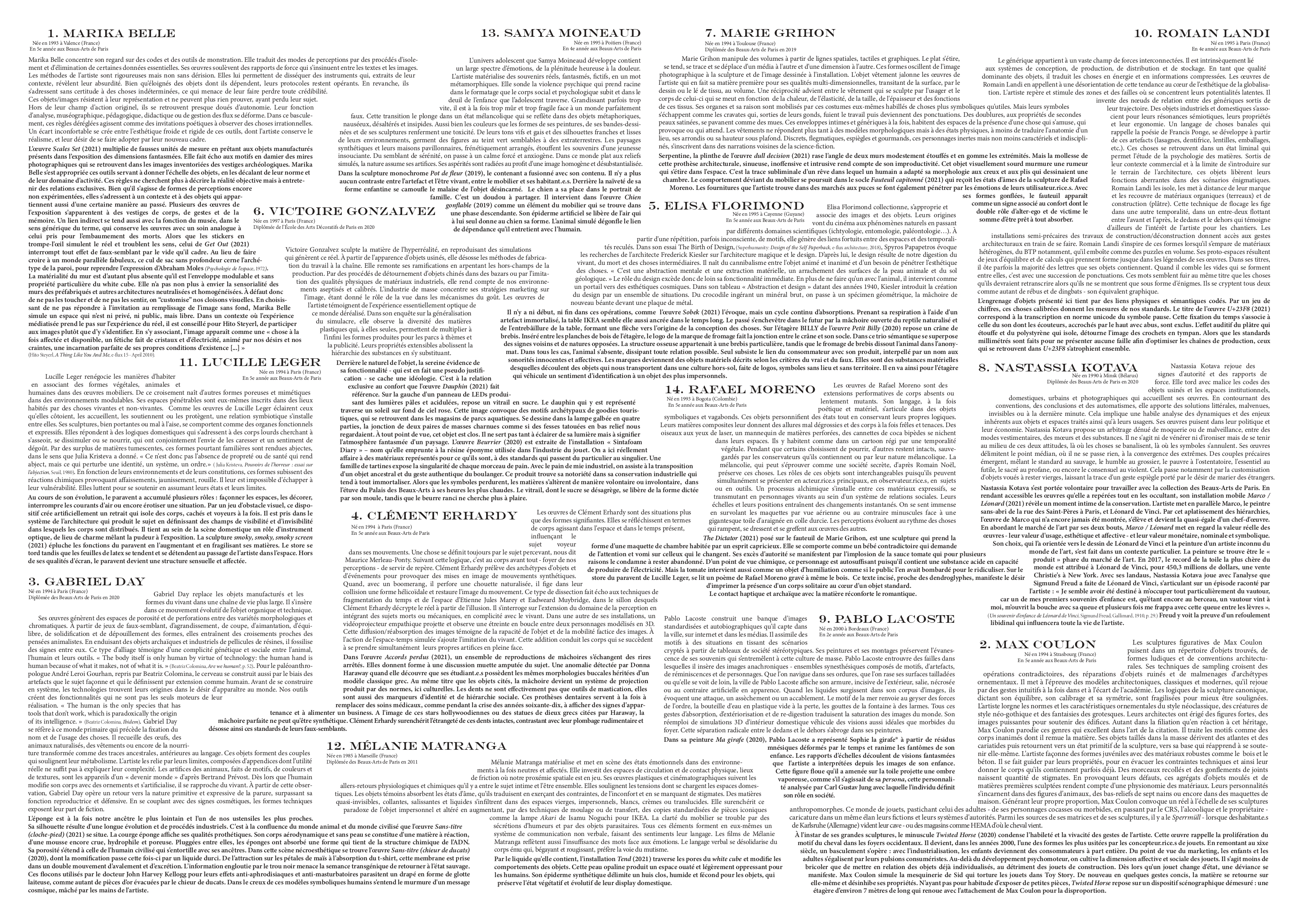CRÛ
texte par Lila Torquéro, commissaire d’exposition, publié à l’occasion de l’exposition CRÛ
Garie Mirhon manipule des volumes à partir de lignes spatiales, tactiles et graphiques. Le plat s’étire, se tend, se trace et se déplace d’un média à l’autre et d’une dimension à l’autre. Ces formes oscillent de l’image photographique à la sculpture et de l’image dessinée à l’installation. L’objet vêtement jalonne les œuvres de l’artiste qui en fait sa matière première pour ses qualités multi-dimensionnelles, transitant de la surface, par le dessin ou le lé de tissu, au volume.
Une réciprocité advient entre le vêtement qui se sculpte par l’usager et le corps de celui-ci qui se meut en fonction de la chaleur, de l’élasticité, de la taille, de l’épaisseur et des fonctions de ces tissus. Ses organes et sa raison sont mobilisés par ces costumes eux-mêmes habillés de choses plus symboliques qu’utiles.
Mais leurs symboles s’échappent comme les cravates qui, sorties de leurs gonds, fuient le travail puis deviennent des ponctuations. Des doublures de vestes de tailleurs, aux propriétés de secondes peaux satinées, se posent sur les dossiers de chaises comme des mues. Ces enveloppes intimes et génériques à la fois, habitent des espaces de la présence d’une chose qui s’amuse, qui provoque ou qui attend.
Les vêtements ne répondent plus tant à des modèles morphologiques mais à des états physiques, à moins de traduire l’anatomie d’un lieu, ses arrondis ou sa hauteur sous plafond.
Discrets, flegmatiques, espiègles et gourmands, ces personnages inertes mais non moins caractériels et indisciplinés, s’inscrivent dans des narrations voisines de la science-fiction.
Serpentine, la plinthe de l’œuvre CHRIS rase l’angle de deux murs modestement étouffés et en gomme les extrémités. Mais la mollesse de cette prothèse architecturale, sinueuse, inoffensive et intrusive rend compte de son improductivité. Cet objet visuellement sourd murmure une rumeur qui s’étire dans l’espace. C’est la trace subliminale d’un rêve dans lequel un humain a adapté sa morphologie aux creux et aux plis qui dessinaient une chambre.
Une réciprocité advient entre le vêtement qui se sculpte par l’usager et le corps de celui-ci qui se meut en fonction de la chaleur, de l’élasticité, de la taille, de l’épaisseur et des fonctions de ces tissus. Ses organes et sa raison sont mobilisés par ces costumes eux-mêmes habillés de choses plus symboliques qu’utiles.
Mais leurs symboles s’échappent comme les cravates qui, sorties de leurs gonds, fuient le travail puis deviennent des ponctuations. Des doublures de vestes de tailleurs, aux propriétés de secondes peaux satinées, se posent sur les dossiers de chaises comme des mues. Ces enveloppes intimes et génériques à la fois, habitent des espaces de la présence d’une chose qui s’amuse, qui provoque ou qui attend.
Les vêtements ne répondent plus tant à des modèles morphologiques mais à des états physiques, à moins de traduire l’anatomie d’un lieu, ses arrondis ou sa hauteur sous plafond.
Discrets, flegmatiques, espiègles et gourmands, ces personnages inertes mais non moins caractériels et indisciplinés, s’inscrivent dans des narrations voisines de la science-fiction.
Serpentine, la plinthe de l’œuvre CHRIS rase l’angle de deux murs modestement étouffés et en gomme les extrémités. Mais la mollesse de cette prothèse architecturale, sinueuse, inoffensive et intrusive rend compte de son improductivité. Cet objet visuellement sourd murmure une rumeur qui s’étire dans l’espace. C’est la trace subliminale d’un rêve dans lequel un humain a adapté sa morphologie aux creux et aux plis qui dessinaient une chambre.
français
Garie Mirhon manipulates volumes from spatial, tactile and graphic lines. Flat surfaces stretches, hold out, lengthen, extend in lines moving from one medium to another and from one dimension to another. These forms oscillate from the photographic image to the sculpture and from the drawn image to the installation. The garnement and furniture design, carrying authoritarian concepts, based on a masculine point of view on the society, constitute a raw material that Garie uses, also for their capacity to convey lines that unfold in volumes.
A reciprocity occurs between the garment that takes its final shape when worn by the user and the body of the latter who moves according to the heat, elasticity, size, thickness and functions of these fabrics.
As an interdependent relation is being weaved between humans and the objects they conceive and produce, Garie offers her pieces a possibility to flee from the function they were assigned in the first place. And as they gain independence, their symbols transform and escape the surface of the fabric : the neck-ties pulled out of their hinges, leaving duty, lengthening on the floor as lazy minimalist sculpture ; in another corner of the space, the linings of tailored jackets rest on the backs of chairs like molts, second-satin-skins. These intimate yet generic envelopes at the same time, inhabit spaces with a feeling of something missing, the presence of an absence that amuses, provokes or perhaps just waits for something to happen.
Clothes no longer respond so much to morphological models but to physical states, unless they reflect the anatomy of a place, its curves, its axes, the height under the ceiling.
Discreet, phlegmatic, mischievous and greedy, these inert yet temperamental and unruly characters are part of narratives bordering on science fiction.
Serpentine, the work CHRIS, not bigger than a plinth, skims the corner of two modestly smothered walls and erases the ends of the space . But the softness of this architectural, sinuous, inoffensive and intrusive prosthesis accounts for its unproductiveness. This visually muffled object whispers a rumor stretching through space. It is the subliminal trace of a dream in which a human adapted his morphology to the hollows and folds that drew the line of a room.
A reciprocity occurs between the garment that takes its final shape when worn by the user and the body of the latter who moves according to the heat, elasticity, size, thickness and functions of these fabrics.
As an interdependent relation is being weaved between humans and the objects they conceive and produce, Garie offers her pieces a possibility to flee from the function they were assigned in the first place. And as they gain independence, their symbols transform and escape the surface of the fabric : the neck-ties pulled out of their hinges, leaving duty, lengthening on the floor as lazy minimalist sculpture ; in another corner of the space, the linings of tailored jackets rest on the backs of chairs like molts, second-satin-skins. These intimate yet generic envelopes at the same time, inhabit spaces with a feeling of something missing, the presence of an absence that amuses, provokes or perhaps just waits for something to happen.
Clothes no longer respond so much to morphological models but to physical states, unless they reflect the anatomy of a place, its curves, its axes, the height under the ceiling.
Discreet, phlegmatic, mischievous and greedy, these inert yet temperamental and unruly characters are part of narratives bordering on science fiction.
Serpentine, the work CHRIS, not bigger than a plinth, skims the corner of two modestly smothered walls and erases the ends of the space . But the softness of this architectural, sinuous, inoffensive and intrusive prosthesis accounts for its unproductiveness. This visually muffled object whispers a rumor stretching through space. It is the subliminal trace of a dream in which a human adapted his morphology to the hollows and folds that drew the line of a room.
english
design par Chloé Cordiale 👀️



.
Catalogue des Félicités 2019


